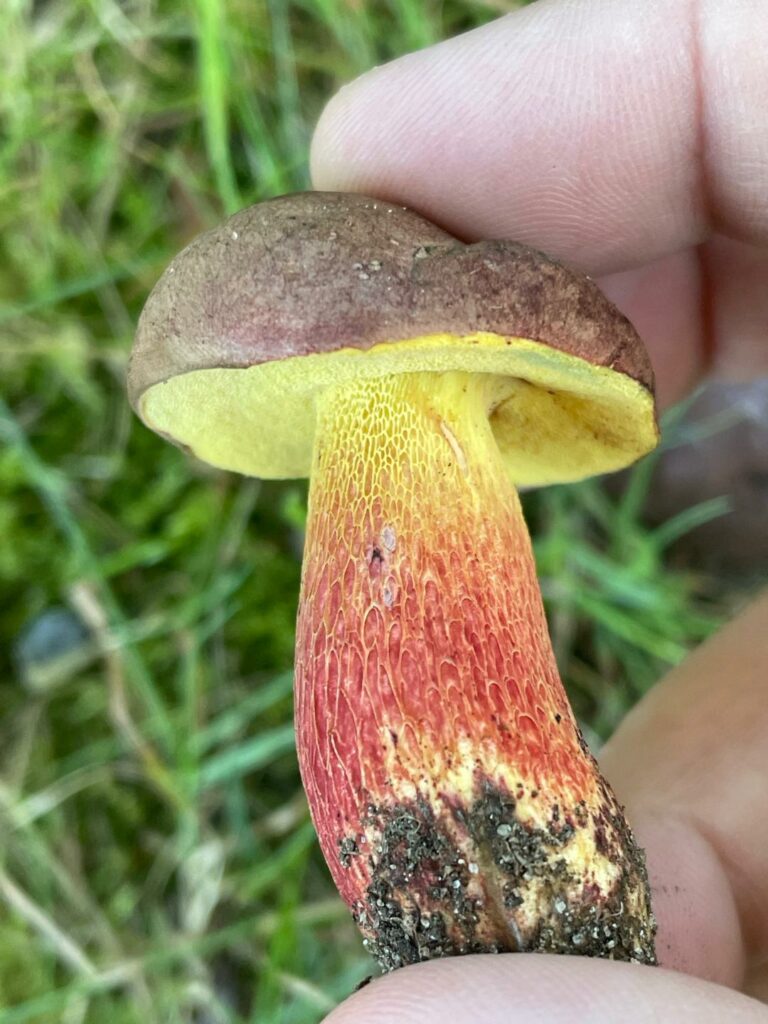Barrington Boy Finds Rare Mushroom Species Never Before Seen in R.I.
September 18, 2023
BARRINGTON, R.I. — Silas Claypool and his dad were exploring the East Bay Bike Path at the end of August when the 10-year-old spotted something unusual on the ground.
Claypool and his father, Rick, both of whom are into mushrooms, picked up the uncommon fungi and brought it home. Turns out, they had discovered a species of mushroom that had never before been found in the state.
Called Boletus billeae, or Billie’s bolete, the mushroom is on a list of underdocumented or potentially threatened species of fungi. Other specimens have been found in Massachusetts, New York, and New Jersey, but none had been previously spotted in the Ocean State.
Silas said once they realized what they had, he was “really excited … really surprised.”
Rick Claypool shared photos of their find with experienced mushroomers on the Boletes of Northeastern North America Facebook group to ask for help identifying the fungi. Experts, including Rhode Island Mycological Society president Deana Thomas, recognized the rare fungus, and urged the Claypools to preserve specimens for DNA analysis. Silas and his dad mailed the specimens, preserved by drying in a food dehydrator, to the Fungal Diversity Survey in California on Sept. 5. Other specimens are to be preserved at the Brown University Herbarium, Rick Claypool said.
Thomas said Silas’s find was indeed significant. “Fungi face the same threats as better-known plants and animals, but currently in Rhode Island — and most of the world — there are no protections in place,” she said, so fungi remain understudied and undervalued.
“Fungi make ecosystems systems, they recycle nutrients and sustain life as we know it,” Thomas said. “A greater understanding of Rhode Island’s fungal diversity and distribution is necessary. With the help of curious people like Silas and his father, we are learning more about fungi, but also the special habitats they call home.”

She continued, “The mushroom Silas found is a mycorrhizal species — it has a symbiotic relationship with nearby trees. Without these trees the fungi cannot survive. So when we study fungi we also learn lots about the habitats we find them in.”
Silas, a fifth-grader at Hampden Meadows School in Barrington, said he’s been into mushrooms for about four years. His interest in fungi began, he said, when “we went on this one walk in the woods, and we just started noticing all these cool mushrooms.” He wanted to know more about them.
Rick Claypool said he had to educate himself about mushrooms to keep up with his son. Silas’ mother bought a field guide about mushrooms and Silas “just devoured it,” Claypool said.
Silas, who is a youth ambassador for the Rhode Island Mycological Society, was recognized by the Western Pennsylvania Mushroom Club when he was 7 for being able to identify more than 50 wild mushroom species.
The Billie’s bolete, a type of mushroom that drops spores from the underside of its cap instead of its gills, has a brown and yellow cap and a yellow stem. The yellow parts, when handled, turn blue. The bolete is believed to grow in sandy soil near oaks and pines. Silas and his dad found the mushroom in an area near Brickyard Pond, where they often find interesting mushrooms.
“Looking for and finding mushrooms is like an endless treasure hunt,” Thomas said. “Even walking the same path every day will reveal new fungi from day to day throughout the seasons. They are always around, if you know where to look.”
Asked if any of his classmates were aware of his noteworthy find, Silas said, “Nobody at my school knows about mushrooms.”
The Rhode Island Myocological Society is holding a “fungal foray” Oct. 7 with the Westerly Land Trust at Wahaneeta Preserve. You can find more information here.




Soo it’s a rare threatened mushroom, and the pick it. Gg
Give the kid a break he picked it so he could get a definitive answer as to what species of mushroom he discovered.
Kudos to Silas for being an expert on mushrooms at his tender age
Is there look-alikes to this species? Im in west glocester and i have these all over my yard. The slugs eat em and love em. Also my kid stomps on em sometimes LOL
Is it poisonous?
It is not.
There was no mention in the article if this found species is edible or poisonous.
The mushroom is not poisonous.
Congratulations Silas but that last comment was unnecessary and untrue – lots of kids at his school know about mushrooms, several of whom he has foraged with and whose families forage.
It isn’t rare, just not common in RI. I pick boletes all over RI, some similar in pine groves. Some in oak.
Picking mushrooms does not destroy the organism. Mushrooms are the fruiting, reproductive part of the organism, like apples on a tree. The bulk of a mushroom is not visible to us but lies in a network of roots called mycelium.